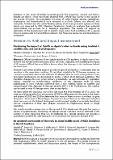Por favor, use este identificador para citar o enlazar a este item:
http://hdl.handle.net/10261/207915COMPARTIR / EXPORTAR:
 SHARE
BASE SHARE
BASE
|
|
| Visualizar otros formatos: MARC | Dublin Core | RDF | ORE | MODS | METS | DIDL | DATACITE | |

| Título: | Monitoring the impact of Xylellaon Apulia’s olive orchards using Sentinel-2 satellite data and aerial photographs |
Autor: | Martínez Sánchez, L.; Scholten, R.; Hornero, Alberto CSIC ORCID; Navas Cortés, Juan Antonio ; Zarco-Tejada, Pablo J. CSIC ORCID; Beck, P. S. A. | Fecha de publicación: | oct-2019 | Citación: | 2nd European conference on Xylella fastidiosa (2019) | Resumen: | Official surveillance of the Xylella fastidiosa(Xf) epidemic in Apulia shows how its front has moved northwards since 2013. However, assessing and modelling the impact of Xf remains difficult because little is known about the damage to the landscape behind the front lines.Sentinel-2 andother satellite sensors provide images of the Earth in wavelengths that are sensitive to the vegetation condition. To test their suitability for Xf damage mapping, we created a model that relies on the shift that Xf-affected olive orchards undergo from a tree-dominated landscape to one dominated by shallow-rooted, short-statured vegetation. This transition changes the way gross primary productivity, as approximated by vegetation indices, responds to meteorological conditions. Insituestimates made by plant pathologists in olive orchards confirmed that a new method based on satellite and meteorological data detected Xf damage severity (R2 = 0.6). Furthermore, this method can be used to map Xf damage every year across Apulia.We then tallied the individual olive trees lost since the first detection of Xf in 2013. We used aerial photographs from the summer of 2013 to delineate each olive tree in the region and photos of 2015 and 2018 to determine how many of them are now crownless, or gone altogether. We trained a Mask Region Convoluted Neural Network to delineate individual olive tree crowns in the 4-band photographs and it proved capable of accurately identifying crowns, irrespective of their size, shapes, proximity to neighbouring trees, or image resolution.Our results provide a unique view on the spread of Xf in Apulia over the past five years, a means of systematically monitoring Xf damage across orchards, and an estimate of the number of olive trees lost thus far. It illustrates how remote sensing can provide a quantitative baseline for addressing the environmental and economic damage of Xf. | Descripción: | Trabajo presentado en la 2nd European conference on Xylella fastidiosa (how research can support solutions), celebrada en Ajaccio el 29 y 30 de octubre de 2019. | URI: | http://hdl.handle.net/10261/207915 |
| Aparece en las colecciones: | (IAS) Comunicaciones congresos |
Ficheros en este ítem:
| Fichero | Descripción | Tamaño | Formato | |
|---|---|---|---|---|
| monitoring_impact_Xylella.pdf | Presentación | 3,11 MB | Adobe PDF |  Visualizar/Abrir |
| monitoring_impact_Xylella_abstract.pdf | Libro de resúmenes | 144,46 kB | Adobe PDF |  Visualizar/Abrir |
CORE Recommender
Page view(s)
159
checked on 22-abr-2024
Download(s)
105
checked on 22-abr-2024
Google ScholarTM
Check
NOTA: Los ítems de Digital.CSIC están protegidos por copyright, con todos los derechos reservados, a menos que se indique lo contrario.
